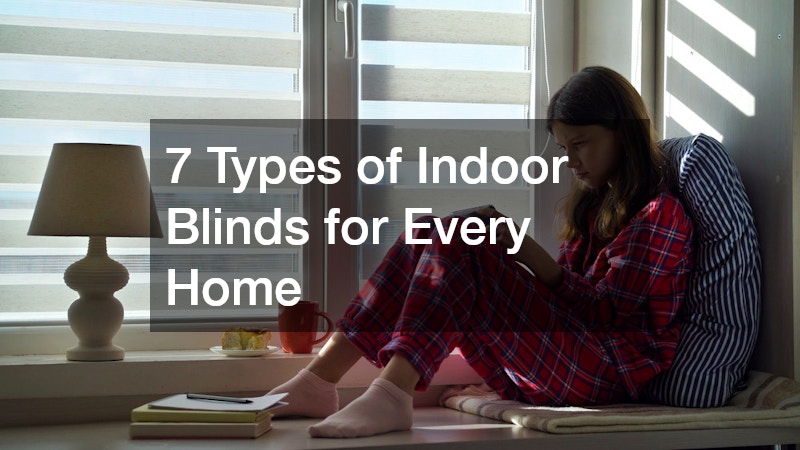Indoor blinds are an essential feature in Australian homes, providing privacy, controlling light and enhancing interior design. Selecting the right type of indoor blinds can transform a room, balancing functionality with style.
With a vast array of options available, it can be overwhelming to choose the perfect fit for your living spaces. This article explores seven popular types of indoor blinds that cater to various needs, styles and budgets, helping homeowners make informed decisions.
1. Venetian Blinds
Venetian blinds remain a classic choice for many Australian homes due to their versatility and timeless appeal. Typically made from aluminium, timber or PVC, these blinds consist of horizontal slats that can be tilted to adjust light and privacy levels. The strength of Venetian blinds lies in their ability to offer precise control over sunlight, allowing homeowners to brighten or darken a room with ease. Timber variants add warmth and a natural texture, complementing both modern and traditional decor. Venetian blinds are especially suitable for living rooms, kitchens and home offices where light control is paramount.
2. Roller Blinds
Roller blinds are a popular option for those seeking simplicity and minimalism. These blinds feature a single piece of fabric that rolls up neatly at the top of the window when not in use. They come in various materials, ranging from sheer fabrics that softly diffuse light to blackout options that completely block it out. Roller blinds suit bedrooms or media rooms where light control and privacy are crucial. Their clean lines and unobtrusive profile make them a practical choice for contemporary interiors. Additionally, roller blinds are easy to maintain and operate, appealing to busy households.
3. Roman Blinds
Roman blinds add an elegant and sophisticated touch to any room. Unlike the flat appearance of roller blinds, Roman blinds fold into soft pleats when raised, creating a graceful and textured look. They are typically made from fabric and come in an array of colours and patterns, making them highly customizable. Roman blinds provide excellent insulation, which can help regulate indoor temperatures—a valuable feature in Australia’s varied climate. Their aesthetic appeal makes them a favourite for living rooms and bedrooms where style and comfort are equally important.
4. Vertical Blinds
Vertical blinds are especially effective for larger windows and sliding doors, which are common in Australian homes. Made of vertical slats that can be tilted or drawn to the side, these blinds offer great flexibility in light and privacy control. They are often manufactured from fabric, PVC or aluminium. Vertical blinds are practical for high-traffic areas such as dining rooms and family rooms, providing a sleek and streamlined look. Their ability to cover wide spaces efficiently without obstructing views makes them ideal for rooms with a connection to outdoor areas.
5. Cellular Blinds
Cellular blinds, also known as honeycomb blinds, are designed with a unique structure that traps air within their cells, offering superior insulation. This makes them an excellent choice for energy-conscious homeowners looking to keep their homes cooler in summer and warmer in winter. Cellular blinds come in single, double or even triple layers, providing varying degrees of insulation and light control. Their soft, fabric-like appearance blends seamlessly into most decor styles, making them suitable for bedrooms, lounges and even kitchens.
6. Pleated Blinds
Pleated blinds are a stylish alternative to roller blinds, featuring a fabric that folds into neat pleats when raised. They provide a modern look with clean lines, while also offering excellent light diffusion. Unlike cellular blinds, pleated blinds do not have the honeycomb structure, but they still serve as effective window treatments in terms of style and function. These blinds are lightweight, easy to operate and available in a variety of colours and patterns. Pleated blinds are well suited to smaller windows or rooms where a soft, elegant touch is desired.
7. Panel Glide Blinds
Panel glide blinds are perfect for covering large expanses of glass, such as sliding doors or wide windows. Comprising large fabric panels that slide smoothly along a track, they offer a modern and minimalist aesthetic. Panel glide blinds can be customised with different materials, including sheer, opaque or textured fabrics, providing flexibility for light control and privacy. Their sleek design complements contemporary homes, particularly open-plan living areas that require efficient shading solutions without sacrificing style.
Choosing the Right Indoor Blinds for Your Home
When selecting indoor blinds, several factors should be considered to ensure the best fit for your home. The room’s purpose, the level of natural light desired, privacy needs and the overall interior style all play a crucial role. For example, blackout roller blinds are perfect for bedrooms, while Venetian blinds offer more precise light control in workspaces. Consider also the maintenance requirements, as some materials may require more care than others.
Indoor blinds not only contribute to your home’s comfort but also enhance its aesthetic appeal. Many homeowners opt for professional installation to guarantee optimal fit and function. Additionally, some blinds come with motorised options, adding convenience and a touch of modern technology to everyday living.
Finding the Perfect Indoor Blinds for Your Australian Home
In conclusion, indoor blinds are more than just window coverings—they are a key element in home design that offers functionality and style. Whether you prefer the classic look of Venetian blinds, the elegance of Roman blinds or the energy efficiency of cellular blinds, there is an option to suit every room and taste. By understanding the characteristics and benefits of each type, Australian homeowners can confidently choose the perfect indoor blinds to complement their homes.
.

